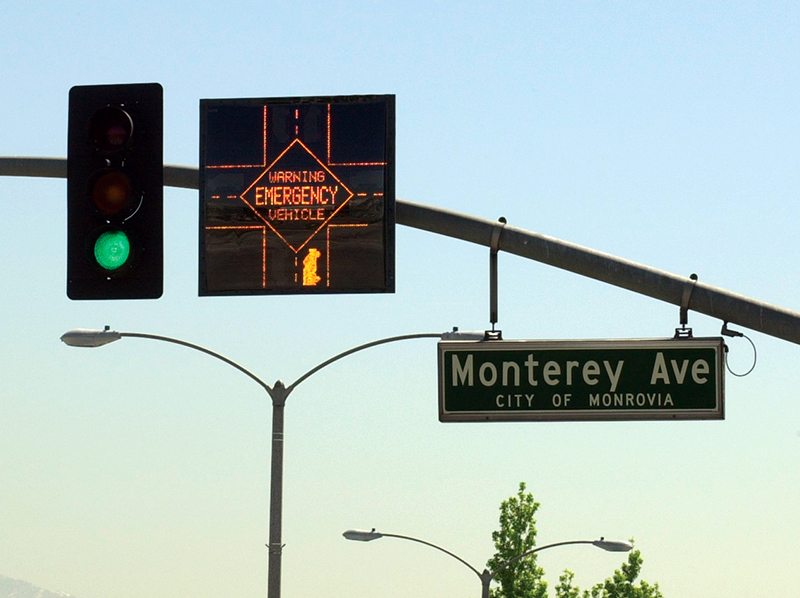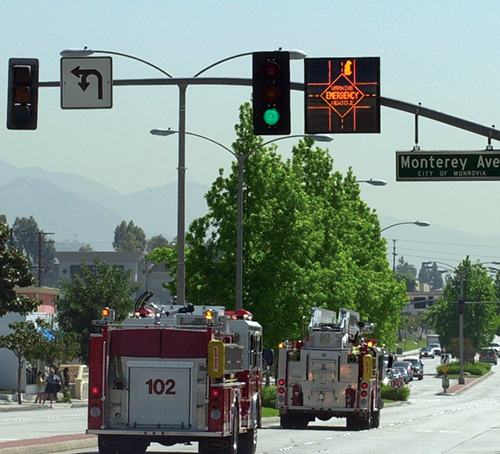
Proceeding With Caution
It took a near-fatal experience for Jim Davidson to realize that traffic signals do not necessarily dictate traffic control. In 1978, Davidson was behind the wheel of a car that was almost struck by a fire truck that sped through a red light on its way to an emergency. Twenty-four years later, Davidson is at the helm of a company that is seeking to make a difference in transportation safety and efficiency with an advanced traffic safety system aimed at curtailing collisions involving emergency vehicles.
As the founder and chief executive officer of Agoura Hills, California-based E-ViEWS Safety Systems, Inc., Davidson has recruited a management team with more than 60 years of traffic control and safety experience to launch the Emergency Vehicle Early Warning Safety System (E-ViEWS), a first-of-its-kind preemption and warning mechanism.
E-ViEWS was developed with assistance from the Technology Affiliates Program at NASA's Jet Propulsion Laboratory (JPL). The system incorporates JPL expertise in the areas of systems engineering, transportation systems, antennas, controls, optical displays, and mechanical systems. It consists of three modules that streamline traffic flow in the presence of emergency vehicles. The first module (E-COMM) alerts motorists and pedestrians that emergency vehicles are approaching an intersection. This is accomplished through traffic signal preemption, a process that utilizes microwave transmissions from an approaching emergency vehicle to immediately change three signal lights to red to halt traffic, and one to green to give emergency vehicles right-of-way passage.
Traffic signal preemption is capable of safely clearing intersections for ambulances transporting emergency patients, fire trucks making their way to a burning blaze, and police cruisers involved in a high-speed pursuit of another vehicle. Secondly, emergency vehicles take advantage of the microwave transmission component to establish an intelligent two-way communication network (E-MITT) with user agencies such as police and fire departments, transit authorities, and street maintenance units.
The third module (E-ViEWS) initiates visual, high-intensity light-emitting diode displays that are positioned above the centers of intersections to inform motorists from which directions emergency vehicles are approaching. The visual displays can be designed to portray changeable messages, street names, detour directions, and maintenance and traffic safety information. E-ViEWS' modular technology can also be applied to non-signalized intersections that incorporate stop signs to direct traffic flow.
The E-ViEWS system acts as a guardrail to protect today's motorists from distractions that could result in serious accidents. Although emergency vehicles use sirens and flashing lights to warn others as they rapidly pass through intersections, some drivers may be oblivious to the emergency situation at hand, due to factors such as car radios, cellular phones, air conditioning, rolled-up windows, vehicle sound proofing, hearing impairment, and many others.
According to the National Highway Traffic Safety Administration, 52 people died in accidents involving emergency vehicles in 1999, the most recent year for which statistics are available. In 1997, an astounding 15,000 emergency vehicle-associated accidents occurred in the U.S. alone. Moreover, National Safety Board metrics indicate that 40 percent of firemen killed in the line of duty die on their way to an incident, mostly from intersection collisions. Knowing this is a worldwide problem, E-ViEWS Safety Systems, Inc., has secured patents in six other countries, with plans for expansion in these major global markets.
Beyond reducing accidents and saving lives, E-ViEWS reduces emergency response times, lessens stress for vehicle operators, cuts back on property loss and equipment damage, lowers municipal insurance premiums, diminishes crime rates, and saves millions of dollars spent on vehicle repairs and costly lawsuits, including liability claims associated with city-owned vehicles.
In spring of 2001, the city of Monrovia, Californialocated just 7 miles from JPL and 28 miles east of Los Angelesdecided to implement the E-ViEWS system at 10 signalized intersections, following a series of bad accidents involving police and fire vehicles in 1999. Transponders that activate the visual warning displays via microwave transmission were installed in 20 police cars and 10 fire vehicles.
Shortly after installation, E-ViEWS faced its first challenge when the Monrovia Fire Department responded to an emergency call from a resident who had experienced severe bleeding after being attacked by a vicious dog. The fire department's emergency route crossed through all 10 intersections that employed the vehicle preemption and visual warning technology. As a result, the fire rescuers reduced their response time by several minutes, which, according to the fire department, later proved to be the difference between life and death for the dog-attack victim.
While E-ViEWS Safety Systems, Inc., continues to forge ahead with its intersection safety system, the company is fully aware that railroad crossings also pose great danger to motor vehicles and pedestrians. According to the Federal Railroad Administration, more than 130,000 public railroad crossings are virtually unprotected, and 97 percent do not have advanced warning devices. Even so, the railroad crossings that are considered as "protected" still experience accidents for numerous reasons, according to E-ViEWS Safety Systems, Inc.
In response, the company has launched testing efforts for Intellirail, a highly intelligent locomotive warning system that is based on the JPL/E-ViEWS preemption emergency vehicle platform. With Intellirail, E-ViEWS Safety Systems, Inc., hopes the system will not only increase crossing safety at highway-rail intersections, but that it will improve traffic flow and relieve congestion by directing drivers to alternative routes that have already been vacated by an oncoming train, and help mitigate locomotive horn blowing in order to establish whistle-free "quiet zones" all across the country.

Although emergency vehicles use sirens and flashing lights to warn others as they rapidly pass through intersections, some drivers may be oblivious to the emergency situation at hand.

High-intensity light-emitting diode displays are positioned above the centers of intersections to inform motorists from which directions emergency vehicles are approaching.













